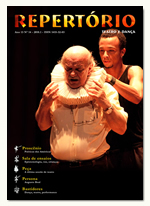<b>Interpretando a talha barroca</b> <br>[Antonio José Faria Góis]
DOI:
https://doi.org/10.9771/r.v0i14.4664Resumo
Os componentes formais e culturais da talha barroca propõem, na sua expressividade, o acesso à mentalidade criativa de uma época; esta, igualmente, solicita nossa compreensão, pela profundidade do seu legado. Em sintonia com a teatralidade do cotidiano, a arte da talha enseja discernir os seus conteúdos a partir da leitura e reavaliaçãodos teóricos preceptistas, os quais abrem o caminho ao estudo essencial dos caracteres morfológicos e estruturais identificáveis em nosso barroco, tão significativo no âmbito do barroco ibero-americano. Com esta intenção, tomamos como referência dois dos nossos templos - a atual Catedral Basílica de Salvador e a igreja conventual de São Francisco,na mesma cidade.
The formal and cultural components of the baroque wood carved table, in its expressivity, improve thepossibility of access to the creative mentality of an age which claimes by the com-prehension of its contents. In accordancewith the quotidian theatricality, the wood carved table motivates the comprehensiveness of its heritage in its deepnesssince the lecturer of the preceptistes teorics, who opens the way to the essential study of the morphologics and structuralscharacteristics that we can identify in the Bahia baroque so significant in the iberian-american circuit. With that intentionwe took as reference two our temples - the Salvador Basilica Cathedral and the Saint Francisco conventual church, in the same city.
Downloads
Downloads
Publicado
Como Citar
Edição
Seção
Licença
Os/as usuários/as poderão ler, baixar, copiar, distribuir, imprimir os textos integralmente desde que sejam claramente mencionadas as referências aos/às autores/as e à Revista Repertório. A utilização dos textos em outros modos depende da aprovação dos/as autores/as e deste periódico.
Os conteúdos emitidos em textos publicados são de responsabilidade exclusiva de seus/suas autores/as e não refletem necessariamente as opiniões da Revista Repertório.








